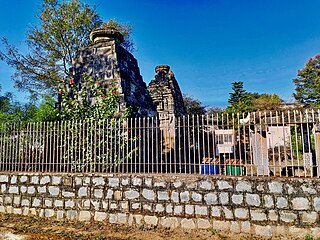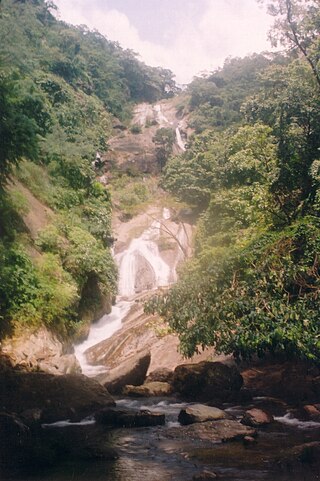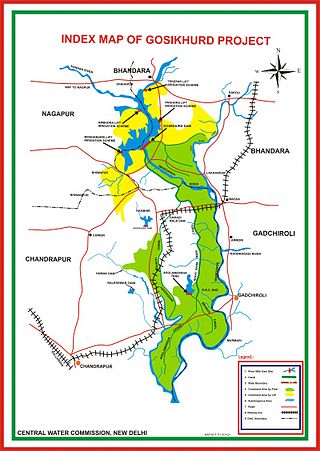
Ulhasnagar is a city located, just 26 km from Thane City in Thane district, Maharashtra, India. This city is a part of Mumbai Metropolitan Region managed by MMRDA. It had an estimated population of 506,098 at the 2011 Census. Ulhasnagar is a municipal city and the headquarters of the Tahsil bearing the same name. It has a suburban station on the Central line of the Mumbai Suburban Railway.

The Wainganga is a river in India originating in the Mahadeo Hills in Mundara near the village Gopalganj in Seoni, Madhya Pradesh. It is a key tributary of the Godavari. The river flows south in a winding course through the states of Madhya Pradesh and Maharashtra, roughly 580 km (360 mi). After joining the Wardha River, the united stream, which is known as the Pranahita River, empties into the Godavari River at Kaleshwaram, Telangana.

Balaghat district is a district of Madhya Pradesh state in Central India. The town of Balaghat serves as its administrative headquarters.

Gondia is a city and municipal council in the Indian state of Maharashtra which serves the administrative headquarters of the eponymous administrative district. Gondia is also known as Rice City due to the abundance of rice mills in the area.Gondia Airport is only airport in district.
Bhandara is a city and municipal council which serves the administrative headquarters of eponymous administrative Bhandara Taluka and Bhandara district in the state of Maharashtra, India. It is connected with NH-53 and NH-247.

Barshi is a city located in Barshi Sub district of Solapur District of Maharashtra State of Republic of India.
Pasrur, is a city of Sialkot District in the Punjab province of Pakistan. The city is the capital of Pasrur Tehsil and is administratively subdivided into 26 wards of the municipal committee Pasrur.
Dharangaon is a city and a municipal council in the Jalgaon district in the Indian state of Maharashtra. AND IT IS THE Dharangaon is also the tehsil headquarters in Jalgaon district. The majority of the population is from the Marathas (Patil), Mali (Phul), Rajput (Purbhe), Dhangar, Badgujar and Teli communities. Dharangaon is the birthplace of the Marathi poet Balkavi.
Karmala is a city and a municipal council in Solapur district in the Indian state of Maharashtra.
The Bandra Municipal Committee was the governing body of the township of Bandra in suburban Mumbai (Bombay) 1876-1950. Initially concerned with the civic functions of Bandra, it expanded to include the suburb of Khar and Santra Cruz by 1933. In 1950, the municipality was merged with the Bombay Municipal Corporation under the Bombay Act No. VII of 1950.

Siruvani Waterfalls and the dam named after them have located 36 km (22 mi) west of Coimbatore in the Western Ghats. The reservoir at Siruvani was built for Tamil Nadu by the Kerala government with funds collected by the Tamil Nadu government to meet the drinking water requirements of Coimbatore. The gateways on either side of the road across the dam are typical of the Kerala and Tamil architectural styles. Siruvani is also home to certain tribes like the Mudugars and Irulas. The view from the falls and the dam is a tourist attraction.

The Pranhita River is the largest tributary of Godavari River covering about 34% of its drainage basin conveying the combined waters of the Penganga River, the Wardha River, and the Wainganga River. By virtue of its extensive network of tributaries, the river drains a large part of Vidarbha region in Maharashtra, as well as the southern slopes of the Satpura Range in southeast Madhya Pradesh. It flows along the border of Gadchiroli district in Maharashtra and Komaram Bheem Asifabad district in Telangana. The Pranahita sub-basin is the seventh largest in India, measuring about 109,078 km2, making it larger than the individual basins of significant rivers such as the Narmada River and Kaveri.
Isakhel is a town of Mianwali District in the Punjab province of Pakistan. The town is the headquarters of Isakhel Tehsil, an administrative subdivision of the district.

Nagpur Municipal Corporation is the municipal body administering Nagpur, in Maharashtra state in Central India.
In India, a Municipal Council is an Urban Local Body that administers a city of population 100,000 or more. However, there are exceptions to that, as previously Nagar Palikas constituted in urban centers with populations over 20,000, so all the urban bodies which were previously classified as Nagar Palikas even if their population was under 100,000. Under the Panchayati Raj system. It interacts directly with the state government, though it is administratively part of the district it is located in. Generally, smaller district cities and bigger towns have a Nagar Palika.
Maan is not a city name. Dahiwadi taluka is called as Maan taluka because land it's situated on Maan river that reason it's called Maan.Sub division dahiwadi is in Satara district of Maharashtra in India. Dahiwadi is tehsil place of maan taluka.
Deolali Pravara Municipal Council is a municipal council that governs Deolali Pravara a town in Rahuri taluka of Ahmednagar district, Maharashtra, an Indian state. The council is a "C" class council and comprises 18 wards.

Mahatma Jyotiba Phule Jan Arogya Yojana, previously Rajiv Gandhi Jeevandayee Arogya Yojana (RGJAY), is a Universal health care scheme run by the Government of Maharashtra for the poor people of the state of Maharashtra who holds one of the 4 cards issued by the government; Antyodaya card, Annapurna card, yellow ration card or orange ration card. The scheme was first launched in 8 districts of the Maharashtra state in July 2012 and then across all 35 districts of the state in November 2015. It provides free access to medical care in government empanelled 488 hospitals for 971 types of diseases, surgeries and therapies costing up to Rs.1,50,000 per year per family. As of 17 January 2016, around 11.81 lakh procedures amounting to Rs.1827 crore have been performed on patients from 7.13 lakh beneficiary families which includes over 7.27 lakh surgeries and therapies. The scheme is called successful amid some allegations of hospitals directly or indirectly causing patients to incur out-of-pockets expenses on some part of the treatment.

GosiKhurd Irrigation Project also known as Indira Sagar Irrigation Project is one of the major irrigation projects in Godavari basin in Indian state Maharashtra in the Bhandara district on the river Wainganga. The project was launched in 7th Five Year Plan by former Prime Minister Rajiv Gandhi during 1984. It has been declared as National Irrigation Project by Government of India.
The Kaleshwaram Lift Irrigation Project (KLIP) is a multi-purpose irrigation project on the Godavari River in Kaleshwaram, Bhupalpally, Telangana, India. Currently the world's largest multi-stage lift irrigation project, its farthest upstream influence is at the confluence of the Pranhita and Godavari rivers. The Pranahita River is itself a confluence of various smaller tributaries including the Wardha, Painganga, and Wainganga rivers which combine to form the seventh-largest drainage basin on the subcontinent, with an estimated annual discharge of more than 6,427,900 acre-feet (7,930 cubic hectometres) or 280 TMC. It remains untapped as its course is principally through dense forests and other ecologically sensitive zones such as wildlife sanctuaries.












